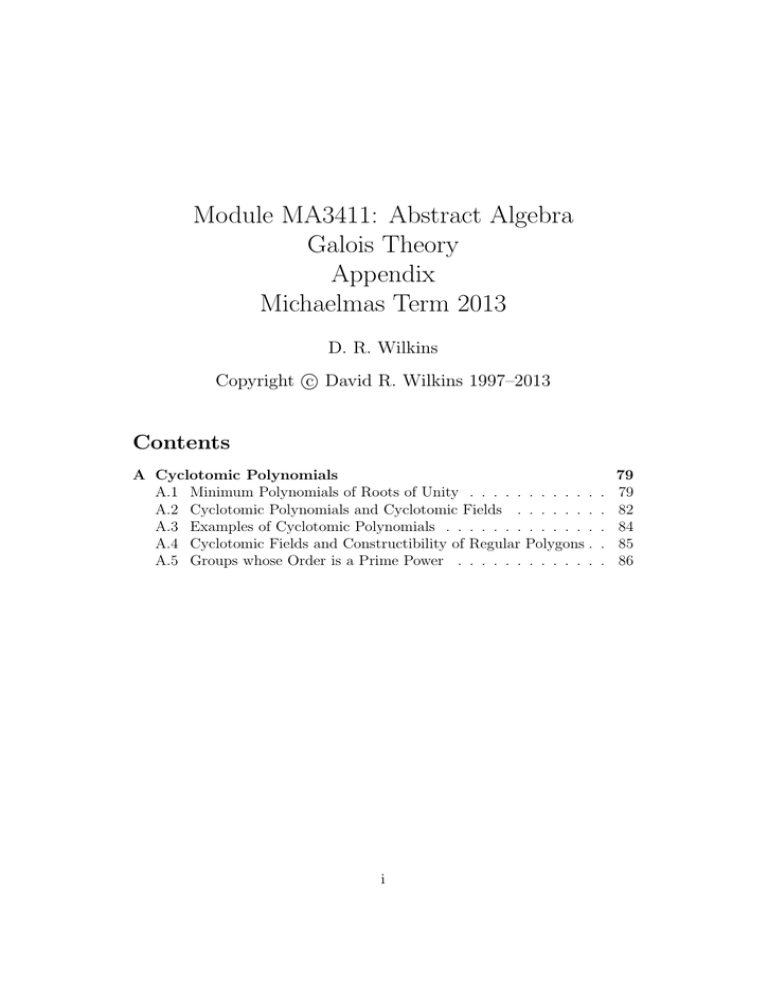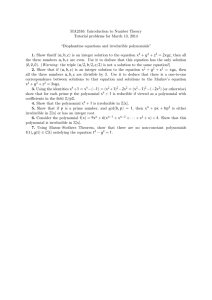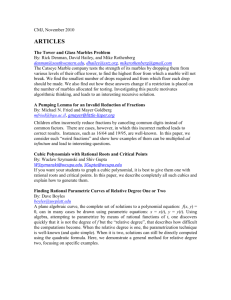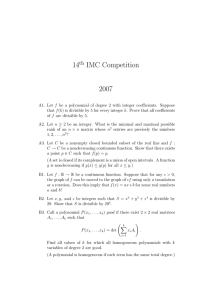Document 10417362
advertisement

Module MA3411: Abstract Algebra
Galois Theory
Appendix
Michaelmas Term 2013
D. R. Wilkins
c David R. Wilkins 1997–2013
Copyright Contents
A Cyclotomic Polynomials
A.1 Minimum Polynomials of Roots of Unity . . . . . . . . . . .
A.2 Cyclotomic Polynomials and Cyclotomic Fields . . . . . . .
A.3 Examples of Cyclotomic Polynomials . . . . . . . . . . . . .
A.4 Cyclotomic Fields and Constructibility of Regular Polygons .
A.5 Groups whose Order is a Prime Power . . . . . . . . . . . .
i
.
.
.
.
.
79
79
82
84
85
86
A
A.1
Cyclotomic Polynomials
Minimum Polynomials of Roots of Unity
Proposition A.1 If a monic polynomial with integer coefficients factors as
a product of monic polynomials with rational coefficients, then those polynomials have integer coefficients.
Proof Let f (x) be a monic polynomial with integer coefficients, and suppose that f (x) = f1 (x)f2 (x) · · · fr (x), where f1 , f2 , . . . , fr are monic polynomials with rational coefficients. Then there exist unique rational numbers
a1 , a2 , . . . , ar such that the polynomial aj fj (x) is a primitive polynomial with
integer coefficients for j = 1, 2, . . . , r. Moreover each rational number aj must
be an integer, because it is the leading coefficient of a polynomial aj fj (x)
whose coefficients are integers. Now Gauss’s Lemma (Lemma 3.7) ensures
that a product of primitive polynomials with integer coefficients is itself a
primitive polynomial. Therefore the polynomial
a1 a2 · · · ar f1 (x)f2 (x) · · · fr (x)
is a primitive polynomial with integer coefficients, and therefore its coefficients are not all divisible by any integer greater than one. Thus a1 a2 · · · ar =
1, and therefore aj = ±1 for j = 1, 2, . . . , r. This then ensures that each factor fj (x) of f (x) has integer coefficients, as required.
Corollary A.2 Let f (x) be a monic polynomial with integer coefficients.
Then the minimum polynomial of every root of f (x) over the field Q of rational numbers has integer coefficients.
Proof If m(x) is the minimum polynomial over Q of some root of f (x) then
f (x) = m(x)g(x) for some monic polynomial g(x) with rational coefficients.
It then follows from Proposition A.1 that the polynomials m(x) and g(x)
have integer coefficients.
Let p be a prime number, let Fp be the field of congruence classes of
integers modulo p, and let νp : Z → Fp be the ring homomorphism that sends
each integer k to its congruence class [k]p modulo p. Then each polynomial
f with integer coefficients determines a corresponding polynomial νp∗ f with
coefficients in Fp , where
νp∗ (a0 + a1 x + a2 x2 + · · · an xn ) = [a0 ]p + [a1 ]p x + [a2 ]p x2 + · · · + [an ]p xn .
for all polynomials a0 + a1 x + a2 x2 + · · · an xn with integer coefficients. The
polynomial νp∗ f is thus obtained from the polynomial f by replacing each
79
coefficient of f (x) by its congruence class modulo p. The function νp : Z[x] →
Fp [x] is a ring homomorphism.
Corollary A.3 Let p be a prime number, and let νp : Z → Fp be the ring
homomorphism from the ring Z of integers to the field Fp of congruence
classes of integers modulo p that sends each integer k to its congruence class
[k]p modulo p. Let f and g be monic polynomials with integer coefficients and
let νp∗ f and νp∗ g be the polynomials obtained on replacing the coefficients of
f (x) and g(x) by their congruence classes modulo p. Suppose that f divides
g in the polynomial ring Q(x). Then νp∗ f divides νp∗ g in Fp (x).
Proof The polynomial f divides the polynomial g in the polynomial ring
Q[x], and therefore there exists some monic polynomial h(x) with rational coefficients such that g(x) = f (x)h(x). But Proposition A.1 then ensures that the monic polynomial h(x) has integer coefficients. It follows that
(νp∗ f )(x) = (νp∗ g)(x)(νp∗ h)(x), and thus νp∗ f divides νp∗ g in Fp [x].
Lemma A.4 Let p be a prime number, and let u(x) be a polynomial with
coefficients in the field Fp of congruence classes of integers modulo p. Then
u(xp ) = u(x)p .
Proof The Commutative, Associative and Distributive Laws satisfied in any
commutative ring ensure that
p X
p
p
(u1 (x) + u2 (x)) =
(u1 (x))p−j (u2 (x))j = (u1 (x))p + (u2 (x))p
j
j=0
for all polynomials u
1 and
u2 with coefficients in the field Fp , because the
p
binomial coefficient
is divisible by p when 0 < j < p (see the proof of
j
!p
r
r
X
X
Lemma 6.10). It follows by induction on r that
uj (x) =
(uj (x))p
j=1
j=1
for all polynomials u1 , u2 , . . . , ur with coefficients in Fp . Also cp = c for all
c ∈ Fp , because Fermat’s Little Theorem ensures that k p ≡ k modulo p for
all integers k. Let
u(x) = c0 + c1 x + c2 x2 + · · · + cpn xn ,
where c0 , c1 , . . . , cn ∈ Fp . Then
(u(x))p = cp0 + cp1 xp + cp2 x2p + · · · + cpn xnp
= c0 + c1 xp + c2 x2p + · · · + cn xnp
= u(xp ),
as required.
80
Proposition A.5 Let m be a positive integer, let p be a prime number that
does not divide m, and let ξ be a complex number satisfying xm = 1. Then
the numbers ξ and ξ p have the same minimum polynomial over the field Q
of rational numbers.
Proof Let f (x) and g(x) be the minimum polynomials of ξ and ξ p respectively over the field Q of rational numbers. The complex numbers are roots of
the polynomial xm − 1. It follows from Corollary A.2 that the monic polynomials f (x) and g(x) have integer coefficients. Moreover g(ξ p ) = 0, and thus
ξ is a root of the polynomial g(xp ). It follows that the minimum polynomial
f (x) of ξ divides g(xp ) in Q[x]. Corollary A.2 then ensures that f (x) divides
g(xp ) in Z[x]. We aim to show that f (x) = g(x).
Let Fp be the field of congruence classes of integers modulo p, let νp : Z →
Fp be the ring homomorphism that sends each integer k to its congruence
class [k]p modulo p, and let f (x) and g(x) be the polynomials with coefficients
in Fp obtained from the polynomials f (x) and g(x) respectively by replacing
each coefficient of those polynomials by its congruence class modulo p, so
that f = νp∗ f and g = νp∗ g. Then f (x) divides g(xp ), because f (x) divides
g(xp ). But g(xp ) = g(x)p , by Lemma A.4. Thus f (x) divides g(x)p . It
follows that all irreducible factors of f (x) in Fp [x] divide g(x)p and are thus
irreducible factors of g(x).
Suppose that it were the case that f 6= g. Then the polynomial xm − 1
would be divisible by f (x)g(x), and therefore the corresponding polynomial
xm − [1]p in Fp [x] would be divisible by f (x)g(x). But we have shown that
each irreducible factor of f (x) is also a factor of g(x). Thus, given any
irreducible factor v(x) of f (x), its square v(x)2 would divide xm − [1]p in
Fp [x]. Thus there would exist some polynomial w ∈ Fp [x] with coefficients
in Fp such that xm − [1]p = v(x)2 w(x). But calculating the formal derivative
in Fp [x] of both sides of this identity shows that
[m]p xm−1 = m.[1]p xm−1 = D(xm − [1]p ) = D(v(x)2 w(x))
= 2v(x)(Dv)(x)w(x) + v(x)2 (Dw)(x),
and moreover [m]p 6= [0]p , because the prime number p does not divide m.
It would therefore follow that the irreducible polynomial v(x) would divide
xm−1 , and would therefore divide x. But this is impossible, because [0]p is not
a root of xm − [1]p and thus could not be a root of v(x). Thus the hypothesis
that f 6= g leads to a contradiction. Therefore f = g, as required.
81
A.2
Cyclotomic Polynomials and Cyclotomic Fields
Let m be a positive integer. A complex number z is an mth root of unity
if z m = 1. It is a primitive mth root of unity if m is the smallest positive
integer for which z m = 1.
Definition The mth cyclotomic polynomial Φm (x) is the monic polynomial
whose roots are the primitive mth roots of unity.
√
Now ωm is a primitive mth root of unity, where ωm = e2π −1/m . Moreover
ω a is a primitive mth root of unity if and only if the integer a is coprime
to m. Indeed an integer j satisfies ω ja = 1 if and only if ja is divisible by
m. If a is coprime to m then ja is divisible by m if and only if j is itself
divisible by m, and therefore ω a is a primitive mth root of unity. On the
other hand if the greatest common divisor (a, m) of a and m is greater than
1, then ω da = 1 where d = m/(a, m) < m and therefore ω a is not a primitive
mth root of unity. Thus
Y
Y
√
a
Φm (x) =
(x − ωm
)=
(x − e2π −1 a/m ),
0≤a<m
0≤a<m
(a,m)=1
(a,m)=1
a
taken over all integers a
i.e., Φm is the product of the polynomials x − ωm
satisfying 0 ≤ a < m that are coprime to m.
Definition The mth cyclotomic field is the field obtained by adjoining the
mth roots of unity to the field Q of rational numbers.
Now the field Q(ωm ) contains all mth roots of unity, because those primitive mth roots of unity are powers of ωm . It follows that the field Q(ωm ) is
the mth cyclotomic field.
Now each mth root of unity is a primitive dth root of unity for some
divisor d of m. It follows that
Y
xm − 1 =
Φd (x),
d|m
where the product of the cyclotomic polynomials Φd (x) is taken over all
divisors d of m.
The Euler Totient Function ϕ is the function on the positive integers
whose value at each positive integer m is the number of non-negative integers
P less than m that are coprime to m. This function satisfies the identity
ϕ(d) = m for all positive integers m, where the sum is taken over the
d|m
divisors d of m (see Lemma 6.13).
82
Theorem A.6 For each positive integer m, the mth cyclotomic polynomial
Φm (x) is a monic irreducible polynomial of degree ϕ(m) with integer coefficients, where ϕ(m) denotes the number of non-negative integers less
than m
√
2π −1/m
that are coprime to m. Moreover the mth cyclotomic field Q(e
) is a
finite extension of Q of degree ϕ(m).
Proof The image of any primitive mth root of unity under an automorphism
of Q(ωm ) must itself be a primitive mth root of unity. It follows that the
Galois group Γ(Q(ωm ): Q) of the Galois extension Q(ωm ): Q permutes the
primitive mth roots of unity amongst themselves, and therefore permutes
a
the factors x − ωm
of the cyclotomic polynomial Φm (x) amongst themselves.
It follows that the coefficients of the cyclic polynomial Φm (x) are in the fixed
field of the Galois group Γ(Q(ωm ): Q). This fixed field is the field Q of rational
numbers (Theorem 6.21). Thus the cyclotomic polynomial Φm (x) ∈ Q(x) is
a polynomial of degree ϕ(d) with rational coefficients.
Now the monic polynomial xm − 1 is the product of the cyclotomic polynomials Φd (x), where this product is taken over all divisors d of m. Moreover
each of these cyclotomic polynomials is a monic polynomial with rational coefficients. It therefore follows from Proposition A.1 that each of the factors
of xm − 1 has integer coefficients. Thus each cyclotomic polynomial Φm (x)
has integer coefficients.
Each integer a coprime to m factors as a product p1 p2 · · · pk of prime
numbers that do not divide m. It follows from successive applications of
p1
p1 p2
p1 p2 ···pk
share the same minimum
Proposition A.5 that ωm , ωm
, ωm
, . . ., ωm
polynomial over the field of rational numbers. It follows that the cyclotomic
polynomial Φm (x) is the minimum polynomial of each of its roots and is thus
irreducible.
The mth cyclotomic field is the field Q(ωm ) obtained by adjoining the
complex number ωm to the field Q of rational numbers. Moreover the cyclotomic polynomial Φm (x) is the minimum polynomial of ωm over the field Q
of rational numbers. It follows from Theorem 4.5 that
[Q(ωm ): Q] = deg Φm = ϕ(m),
as required.
If m is a prime number then all mth roots of unity with the exception of
the number 1 itself are primitive mth roots of unity, and therefore
m−1
xm − 1 X j
Φm (x) =
=
x
x−1
j=0
(provided that m is prime)
83
A.3
Examples of Cyclotomic Polynomials
We now list the first eight cyclotomic polynomials:
Φ1 (x)
Φ2 (x)
Φ3 (x)
Φ4 (x)
Φ5 (x)
Φ6 (x)
Φ7 (x)
Φ8 (x)
=
=
=
=
=
=
=
=
x − 1,
x + 1,
(x − ω3 )(x − ω32 ) = x2 + x + 1,
√
√
(x − −1)(x + −1) = x2 + 1,
x4 + x3 + x2 + x + 1,
(x − ω6 )(x − ω65 ) = x2 − x + 1,
x6 + x5 + x4 + x3 + x2 + x + 1,
(x − ω8 )(x − ω83 )(x − ω85 )(x − ω87 ) = x4 + 1.
Example We calculate Φ8 (x). Now
ω8 e2π
ω83 e2π
where i =
√
√
√
−1/8
−1/8
√
= (1 + i)/ 2,
√
= (−1 + i)/ 2,
−1. Moreover ω − 84 = −1. It follows that
Φ8 (x) = (x − ω8 )(x − ω83 )(x − ω85 )(x − ω87 )
1+i
−1 + i
1+i
−1 + i
=
x− √
x− √
x+ √
x+ √
2
2
2
2
2
2
(1 + i)
(−1 + i)
=
x2 −
x2 −
= (x2 − i)(x2 + i)
2
2
= x4 + 1.
A direct calculation shows that
Φ1 (x)Φ2 (x)Φ3 (x)Φ6 (x) =
=
=
=
(x − 1)(x + 1)(x2 + x + 1)(x2 − x + 1)
(x2 − 1)((x2 + 1)2 − x2 )
(x2 − 1)(x4 + x2 + 1)
x6 − 1.
This verifies that x6 − 1 is indeed the product of the cyclotomic polynomials
Φd (x) taken over all divisors d of 6.
84
A.4
Cyclotomic Fields and Constructibility of Regular
Polygons
Let K denote the set of all real numbers x for which the point (x, 0) is
constructible from the points (0, 0) and (0, 1) by means of a geometrical
construction using straightedge and compasses alone. Then K is a subfield
of the field of real numbers, and a point (u, v) of the plane is constructible
using straightedge and compass alone√ if and only if u ∈ K and v ∈ K.
Moreover if u ∈ K and u > 0 then u ∈ K. (These results follow from
Theorem 5.3.) Moreover if u ∈ K then [Q(u): Q] = 2r for some non-negative
integer r (Theorem 5.7).
Suppose that a constructible
point (u, v) lies on the unit circle, so that
√
u2 + v 2 = 1. Then [Q(u, v, −1): Q(u)] is equal to 1, 2 or 4, because v 2 =
1 − u2 and therefore [Q(u + iv): Q] is a power of 2. Now a regular m-sided
polygon inscribed in the unit circle is constructible if and only if the point
(cos(2π/m), sin(2π/m)) is constructible. It√follows that if this regular msided polygon is constructible then [Q(e2π −1/m ): Q] = 2r for some nonnegative integer r, and thus ϕ(m) = 2r for some integer r, where ϕ denotes
the Euler Totient Function.
Suppose that m = pr11 pr22 · · · prkk where p1 , p2 , . . . , pk are distinct prime
numbers and r1 , r2 , . . . , rk are positive integers. It follows from well-known
results of elementary number theory that
ϕ(m) = pr11 −1 (p1 − 1)pr22 −1 (p2 − 1) · · · prrk −1 (pk − 1).
Thus ϕ(m) is a power of 2 if and only if rj = 1 and pj − 1 is a power of two
whenever the prime pj is odd. Moreover if pj − 1 = 2t for some integer t
then t cannot have any odd divisors, because the polynomial x + 1 divides
xn + 1 for all odd positive integers n and therefore 2s + 1 divides 2ns + 1 for
all odd positive integers n and positive integers s. Thus if pj − 1 is a power
nj
of 2 then pj must be of the form 22 + 1 for some non-negative integer nj .
Prime numbers of this form are known as Fermat primes. We conclude that
a positive integer m satisfies ϕ(m) = 2r for some non-negative integer r if
and only if either m is a power of 2 or else m is a power of 2 multiplied by a
product of distinct Fermat primes.
The five known Fermat primes are 3, 5, 17, 257 and 65537.
The theory of straightedge and compass constructions thus shows that if
an m-sided regular polygon is constructible using straightedge and compasses
then [Q(ωm ): Q] must be a power of 2. The converse result is also true.
Indeed suppose that [Q(ωm ): Q] is a power of 2. The splitting field
extension Q(ωm ): Q is a Galois extension, and therefore its Galois group
85
Γ(Q(ωm ): Q) is a finite group whose order is 2r for some integer r. A standard result of group theory then ensures that the Galois group Γ(Q(ωm ): Q)
has subgroups H0 , H1 , . . . , Hr , where |Hj | = 2r−j for j = 0, 1, . . . , r and Hj
is a normal subgroup of Hj−1 for j = 1, 2, . . . , r. (This result is a special
case of Corollary A.9 below.) Let the subfield Lj of Q(ωm ) be the fixed field
of Hj for j = 0, 1, . . . , r. It then follows from the Galois Correspondence
(see Theorem 6.25) that [Lj : Q] = 2j for j = 0, 1, . . . , r and Lj−1 ⊂ Lj for
j = 1, 2, . . . , r. Then [Lj : Lj−1 ] = 2, and therefore Lj = Lj−1 (αj ) for some element αj satisfying αj2 ∈ Lj−1 . Let K be the subfield of R consisting
√ of those
u ∈ K for
real numbers u for which the point (u, 0) is constructible.
Then
√
all u ∈ K. It follows that that if Lj−1 ⊂ K( −1) then√the real and imaginary parts of αj belong to√K, and therefore Lj ⊂ K( −1). We conclude
from this that Q(ωm ) ⊂ K( −1), and thus the real and imaginary parts of
each element of Q(ωm ) are the Cartesian coordinates of a constructible point
in the Euclidean plane.
We conclude therefore that if ϕ(m) is a power of 2 then a regular m-sided
polygon inscribed in the unit circle is constructible using straightedge and
compasses.
We now discuss the results from group theory that ensure that any finite
group whose order is a power of 2 contains a finite sequence of subgroups,
where each proper subgroup in the sequence is a normal subgroup of the
preceding group in the sequence whose order is half that of the preceding
subgroup. These results are special cases of results that apply to any finite
group whose order is a power of a prime number.
A.5
Groups whose Order is a Prime Power
Definition Let p be a prime number. A p-group is a finite group whose
order is some power pk of p.
Lemma A.7 Let p be a prime number, and let G be a p-group. Then there
exists a normal subgroup of G of order p that is contained in the centre of G.
Proof Let |G| = pk . Then pk divides the order of G but does not divide the
order of any proper subgroup of G. It follows from Proposition 8.2 that p
divides the order of the centre of G. It then follows from Cauchy’s Theorem
(Theorem 8.3) that the centre of G contains some element of order p. This
element generates a cyclic subgroup of order p, and this subgroup is normal
since its elements commute with every element of G.
86
Proposition A.8 Let G be a p-group, where p is some prime number, and
let H be a proper subgroup of G. Then there exists some subgroup K of G
such that H / K and K/H is a cyclic group of order p.
Proof We prove the result by induction on the order of G. Thus suppose
that the result holds for all p-groups whose order is less than that of G. Let
Z be the centre of G. Then ZH is a well-defined subgroup of G, since Z is
a normal subgroup of G.
Suppose that ZH 6= H. Then H is a normal subgroup of ZH. The
quotient group ZH/H is a p-group, and contains a subgroup K1 of order p
(Lemma A.7). Let K = {g ∈ ZH : gH ∈ K1 }. Then H / K and K/H ∼
= K1 ,
and therefore K is the required subgroup of G.
Finally suppose that ZH = H. Then Z ⊂ H. Let H1 = {hZ : h ∈ H}.
Then H1 is a subgroup of G/Z. But G/Z is a p-group, and |G/Z| < |G|,
since |Z| ≥ p (Lemma A.7). The induction hypothesis ensures the existence
of a subgroup K1 of G/Z such that H1 / K1 and K1 /H1 is cyclic of order p.
Let K = {g ∈ G : gZ ∈ K1 }. Then H / K and K/H ∼
= K1 /H1 . Thus K is
the required subgroup of G.
Repeated applications of Proposition A.8 yield the following result.
Corollary A.9 Let G be a finite group whose order is a power of some prime
number p. Then there exist subgroups G0 , G1 , . . . , Gn of G, where G0 is the
trivial subgroup and Gn = G, such that Gi−1 / Gi and Gi /Gi−1 is a cyclic
group of order p for i = 1, 2, . . . , n.
87






